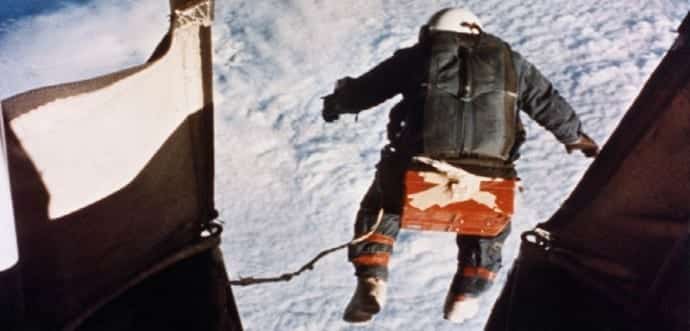Space Men on PBS brings out a new hero in pre-NASA space adventures
American Experience is a documentary series that covers portions of US history. This also includes an episode on “pre-astronauts”. Space Men scheduled to premiere on Tuesday at 9pm ET on PBS (Public Broadcasting Service) is expected to show the people who made to the edge of space and tested human physiology in extreme environments before NASA rose to fame.
Space Men recounts two initiatives – Project Manhigh and Project Excelsior – in which explorers went up as high as 102,800 feet in helium-filled balloons to understand the freezing cold and near zero atmospheric pressure of such altitudes. These missions in some ways laid the platform for Project Mercury, which would come shortly after.
This episode shows John Paul Stapp, a physician who entered the Army Air Corps in 1944, as an out-of-his-time man who predicted that one day humans would fly into space.
There were many more questions than answers back in the 1940s. How high was too high for humans? How would humans behave at high altitudes? Was there a maximum speed the human body could bear? Would cosmic rays in the upper atmosphere blind people? Was there a boundary to how far one could fall? Stapp is likely most well-known for his exploration of the question about g-forces. However, how much could the human body stand?
In order to find out humans would react to such a harsh environment, Stapp started performing experiments. Space Men has fabulous footage of this aerospace inventor strapping himself into a “rocket sled” and hurrying down a track before braking quickly. Stapp did not believe in exposing others to such harsh conditions without going through it first. Until his last ride in the sled, he went through a series of gradually harsh experiments in the 1950s – when he reached a velocity of 632mph. It was a land speed record at that time, but Stapp’s top velocity only lasted a few moments before he hit the brakes hard within seconds. He pulled 46.2G.
While no human had ever come close to such dangerous conditions at that time them, no one has managed to come close since. Stapp finally recovered despite him losing vision for a time after this final extreme run down the track. The US Air Force however failed to predict the coming space race and didn’t see the value, in spite of brave Stapp’s experiments. He had to continuously fight for financing.
He finally found enough to carry out Project Manhigh, in which Col. Joseph Kittinger flew to 96,784 feet in gondola in 1957. This was trailed by other researchers into a territory above 99 percent of the Earth’s atmosphere. The Soviet Union launched Sputnik into space in October 1957 shortly after Stapp and Kittinger’s feat. He helped NASA develop a regimen of tests from the information Stapp had obtained, which led to the selection of the Mercury 7 astronauts.
Stapp’s last major “space” initiative was Excelsior, in which the Air Force wanted to gather data about pilots jumping out from high-altitude jets. How high could a human survive a jump from? On August 16, 1960, they figured it out when Kittinger, a test pilot, climbed into the balloon, rose to the edge of space, and then jumped into the unknown. He landed safely some 13 minutes and 45 seconds later.
“I was used to going up and flying in unusual situations, and this was an extension of that,” Kittinger told Ars in an interview. “I’d gone through this jump 1,000 times in my mind and worked to get ready for it for 1.5 years. So when it came time to jump I was ready to go, I confidence in my team, and in my equipment. Gravity is a law, and I knew I was going to go down.”
Kittinger who regarded Stapp as a visionary who never got his due said that he was glad to see that Space Men had put such a strong focus on Stapp. “He was the bravest man I ever met in my life because that man knew exactly what was going to happen to himself before he undertook a sled run,” Kittinger said. The awe in his voice comes from a man who jumped from a balloon 102,800 feet above the Earth 55 years ago.
A peek into Stapp’s background shows that while he exposed himself to violent crash simulations, he realized that more Air Force personnel were dying in automobile crashes than airplane crashes. He understood that automobile safety was a large issue.
According to Craig Ryan, the author who wrote about the Air Force physician in 1955, Stapp set up the first independent conference on automobile safety to prevent major injury and death from accidents. He appeared before Congress numerous times and suffered the ire of the Big Three automakers. In fact, Detroit fought hard but they lost in the end.
In 1966, when President Lyndon Johnson signed the National Traffic and Motor Vehicle Safety Act into law, Stapp was present in the Rose Garden to attend the ceremony. He became the National Highway Traffic Safety Administration’s chief medical scientist. Seat belts became standard equipment in US automobiles two years later. The successors to Stapp’s earliest space men, humans landed on the Moon a year after that.
Resource : Ars Technica.

